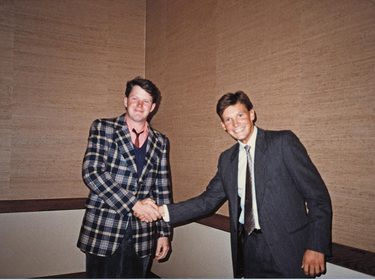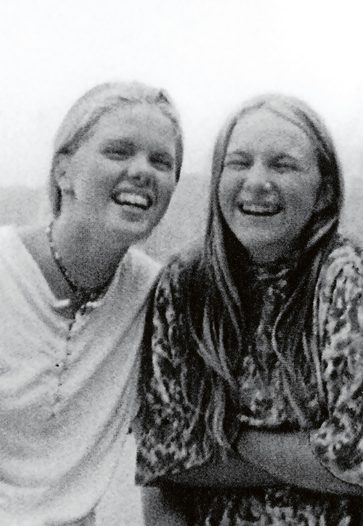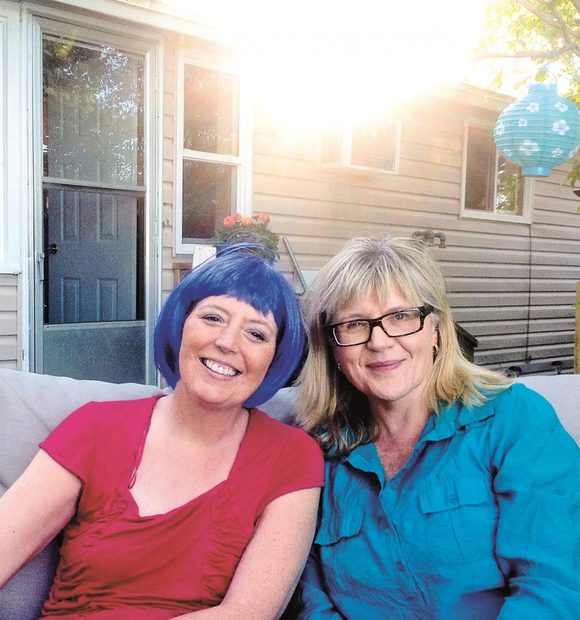
Winning Teams, by Curtis Gillespie
When it comes to making friends, some people have all the luck.
Arcane wrestling manoeuvres such as the Anaconda Vise, the Rebound Clothesline and the Mongolian Chop aren’t typically referred to as solid pillars on which to form lifelong friendships. Empathy and respect tend to get more play, and I’m sure they work. On the other hand, a Corkscrew Elbow Drop can separate the pretenders from the contenders.
In the fall of 1984, I was an arts undergrad at the University of Alberta, and the Rutherford Library was my second home. One afternoon, I picked up the September 24 issue of the Alberta Report and was immediately drawn to the cover story about the final days of Stampede Wrestling, the famous live TV series. Soon I was crying with laughter, which was when a guy to my left leaned over. He wanted to know what I found so funny.
Unable to speak, I pointed to the section about the infamous six-man tag-team match featuring the hero team led by Bret Hart against the villain crew of Archie “The Stomper” Gouldie, which included the reviled Bad News Allen. After weathering an early thrashing, Hart’s team instigated a comeback, but Bad News Allen perpetrated a disgraceful double-cross. The writer summed up what had happened: “Bad News Allen, crazed, pulled a DINNER FORK from his shorts, brandished it before the stunned crowd and then proceeded to plunge the fork into the forehead of Archie ‘The Stomper’ Gouldie, HIS OWN TEAMMATE!!”
The glasses of the fellow beside me immediately misted over from his own tears. He removed them and recited the paragraph out loud a couple of times. Every repetition of “HIS OWN TEAMMATE!!” made us hold our stomachs and howl yet again.

Fifteen minutes later, we introduced ourselves. His name was Bruce. Over the next few days, I found out he played squash (like me), played Ping-Pong (like me), was an ardent reader (like me) and wanted to be a writer (like me). I’ve now known Bruce longer than I knew my dad, who died at age 60. Bruce was the MC at my wedding 22 years ago, and I returned the favour a few years after.
Today, every conversation-whether we’re discussing fatherhood, a writing project or the hockey performance of the Sedin twins-still finds us laughing, usually over nothing more than the bits of code close friends use as putty to fill in life’s hull cracks. Finding a message from Bruce on my phone screaming “GOAAAAAL!!!” can turn a whole day around.
I’ve always felt there must be some force-a kind of gravitational empathy-that puts us near like-minded souls. I didn’t have many friends in high school (I was short, fat, the object of teasing), but by the time I went to university, my friendship door was open (I was taller, less spherical). I had passed through a difficult period and was ready and in the right place. I guess Bruce was, too.
And it’s a place worth revisiting, since in some ways the entire arc of a friendship can be found in its first fortuitous moments. I know that if Bruce were ever to cause conflict in our relationship, I would simply have to extract a dinner fork from my shorts and rake it across his forehead to restore equilibrium. The best friendships should always be able to return to their roots.
Stand by Me
“Helena has been my best friend and soulmate for 47 years. We met in Grade 9 and bonded because we both had skipped a grade and weren’t as, well, curvy as the other girls. Our bodies caught up the next year, though, and we became cheerleaders. We roomed together in college. We stood up for each other at our weddings and stood beside each other at the funerals of our parents. She has been my port of call for every crisis. Each conversation with her leaves me feeling happier and lighter.”
– Melanie Trimble,Orangeville, Ont.
Mirror Image
“I never had trouble making friends, but the relationships rarely went very deep. That changed in 1990, when my mother called to confess a secret: she had had a baby girl out of wedlock in 1951. She had given the child away, then met my dad two years later and gotten married in 1954. She had never mentioned her first-born to any of her other three kids. But now she had no choice: my half-sister-a 38-year-old wife and mother named Donna Ann Mersereau-had finally tracked her down. Donna and I arranged to have coffee a few months later. Like a meeting between long-lost twins, the encounter was overwhelming and oddly familiar. We shared the same face, same body shape, same laugh, same gestures. I immediately knew that I could tell her anything. Twenty-four years later, she’s still one of the few people with whom I can be completely honest.”
– Sandy Stevenson, Edmonton

Once Upon a Time, by Emily Urquhart
Sometimes the greatest friendships begin with a story.
We both tell the tale the same way. It was the first day of kindergarten, and Kristin and I wore identical brown tartan dresses. That’s all it took to claim each other as a best friend. It seemed more preordained than coincidence. This is how I understood the basis for our friendship when I was four. I’m still inclined to believe it was fated.
Our relationship was cemented by an immense capacity for imaginative play. We’d reinvent ourselves as swashbucklers named Rose and Kris, and create a vast kingdom dotted with castles and fast-running streams we needed to cross to outrun our enemy-a shape-shifter named Dugly Ugly, who would materialize in the form of a boy, man or wild animal. If he captured one of us, the other would rush to the rescue. The allure of this game was that, when circumstances looked bleak, we always devised a new outcome.
Dugly Ugly followed us to elementary school, after we were ostracized by our classmates. It was Grade 6, a time when cliques bloom and kids are ruthless. Kristin committed a faux pas-long forgotten now-and we found ourselves banished to the fringes of the schoolyard for an entire winter. At recess, we’d escape into other realms-shared worlds where we made the rules and controlled our fates. Being bullied might have been traumatizing, but together it was just another adventure.
As we grew older, our exploits happened in the real world and took us far from home-working at a canoe-tripping camp, touring Ireland, visiting each other in our respective university towns. Then, when I was 24, my half-brother died from complications related to alcoholism. Being 11 years my senior, he was protective, indulgent, goofy and endlessly kind. I knew he struggled with addiction but never imagined it might kill him. It was the saddest story in the world, and I couldn’t bear to share the details, so I barred my friends from the funeral.
Kristin alone ignored my wishes. I can still picture her at the wake in the church basement, standing nearby as I made small talk with the mourners-all of whom were there for my parents or my siblings. Kristin was there just for me. We were a unit, like on the playground. She couldn’t rescue me from this tragedy, as she might have done in our make-believe world, but showing up was enough. Her act of disobedience taught me that, when dealing with a distressed friend, sometimes you need to override what you’re told and do what you feel is right.
Lately I’ve been watching my four-year-old daughter form her first friendships. She tells me about her days at preschool, the kids she plays with and the games they invent. The name of one little girl surfaces more often than the others. Thinking of Kristin, I wonder what role this child might play in the story of my daughter’s life.
Unbreakable Bonds
“My ex-husband will always be my best friend. We were married 28 years and divorced in 2000. Things didn’t work out between us, but not because we disliked each other. In fact, even during the sadness of those final days we were able to talk through our problems. He has since remarried to a wonderful woman, but there’s still a great deal that happens to me that I want to share with him. We have four kids and seven grandchildren-it’s not the kind of history either of us wants to throw away.”
– Judy Zuber, Hanover, Ont.

Karen and Me, by Moira Farr
What can friendship teach us about death?
Some days, it was sparkling water in a tall glass, with a straw; other days, plain water, no straw. Can you add ice? Wait, no ice. But cold. Not that cold. Make it a short glass. Forget the water. Do we have ginger ale? Oh. Didn’t I put that on the shopping list?
“Next time, tell her to go to hell,” joked one of Karen’s brothers. But given the circumstances, it wasn’t difficult to forgive her moments of micromanaging. It was the summer of 2013, and we were holed up in her cabin on Pike Lake, near Saskatoon. Karen and I hung out a lot in our younger decades as Toronto journalists. Single women with constant guy problems, we both struggled with depression, we both met men we stayed with for about 13 years, and we both hit our 50s childless and single again. So when she asked me to join her while she went through chemotherapy for Stage 4 breast cancer that had spread to the bone, I didn’t hesitate. By then, we knew each other, with all our flaws, as well as any two friends. Whether in the same city or separated by thousands of kilometres, we always looked out for each other.
The lake was spectacular. At night, coyotes yipped and howled, and nesting red-necked grebes called to one another. All that thriving life must have comforted Karen, bundled in blankets on her sofa, as she gradually lost her lovely red hair. We talked, laughed and cried in much the same way we had in our youth-wine included. She ordered wigs online, silly ones and beautiful ones. She artfully applied makeup and posted her picture on a singles site, contemplating one last blast of dating. That June, her nieces threw her a huge birthday party-her last, as it turned out. When the fire-eating belly dancer offered Karen her lit baton, she put it in her mouth and, wearing a glossy blue hairpiece, breathed out flames.
And her car! We crawled over Saskatoon potholes to and from the cancer centre in a pink 1957 Rambler she’d had restored after her diagnosis and called her “random act of silliness.” The vehicle drew gasps and smiles from passersby. (I wasn’t so keen because it had loose, frayed lap belts. She didn’t care-“I’m dying anyway,” she’d laugh.)
Getting in and out of the car eventually became an ordeal, Karen often sobbing with pain as she edged along on her walker or lowered herself into her wheelchair. Then, in July, after a second round of chemo, Karen decided to stop. I found myself bargaining. If finishing the regimen bought her extra time, why not do it? She was firm. She’d had a rich, varied life. She wasn’t leaving children behind. She didn’t have a partner. Why hang around?
I’m not sentimental about death and know perfectly well not everyone survives cancer. Still, I was devastated and oddly hurt by her reasoning. Did not having kids or a mate make a woman’s life less worth living? What did that say about mine?
But then, it wasn’t me with the cancer. Karen spent her remaining days at her house in the warmth of Phoenix-where she usually wintered-fostering rescue dogs and putting her affairs in order. When she died in April 2014, at 52, I accepted she had gone on her own terms. The acceptance hasn’t made it any easier to absorb the loss of her adventurous spirit and good humour. In December 2012, soon after she was diagnosed, we had gone to Rome to visit friends. She wanted
to see the Sistine Chapel. I pushed
her in a wheelchair around the magnificent space. We joked about
becoming an innocent-seeming pickpocketing duo. “It’s how we roll,” she said.
Buddy System
“One of the marks of a true friend is that they help to make you a better person. Kara is the one who taught me the most about patience. We were both single moms when we met 21 years ago. At the time, I was quick-tempered, always snapping at my kid. But when I saw her deal calmly with her son, I said to myself: I can do that. Kara set an example that changed my life as a parent.”
– Angela Legge, Labrador City, N.L.